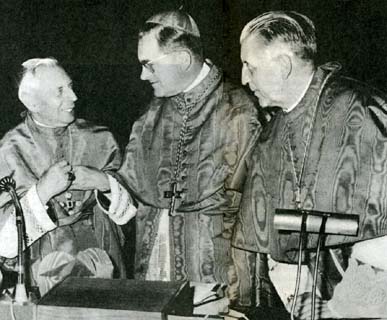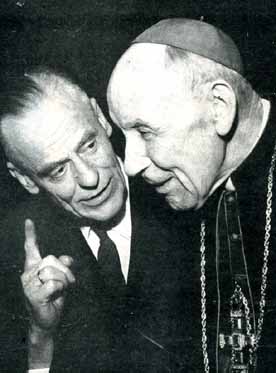THE GROWING REJECTION OF VATICAN II – With the 40th anniversary of the closing of the Council on December 8, many commentators are returning to the scenes of Vatican II and making evaluations of the ensemble of its work. It is time for me to say a word also.

From left to right, Cardinals Lercaro, Döpfner and Suenens at the Council. The three Moderators chosen by Paul VI to pushed the progressivist agenda - 30 Dias, March 1993
|
In essence Vatican II constituted a Revolution in the Church.
This Revolution was directed by John XXIII and Paul VI. The latter was represented in the conciliar assembly from the second session to the closing by three Moderators chosen by him – Cardinals Leo Suenens, Giacomo Lercaro, and Julius Döpfner.
This trio and a team of other Prelates did everything they could to promote Progressivism in the general meetings at St. Peter's Basilica. They included Cardinals Agostino Bea, president of the Secretariat for Christian Unity, former confessor of Pius XII and close friend of John XXIII; Joseph Frings, Archbishop of Cologne and head of the German Episcopate; Achille Liénart, Bishop of Lille and president of the French Bishops Conference, and Bernard Alfrink, Archbishop of Utrech.
A group of periti [experts] also did everything they could to promote Progressivism in the work of the commissions that prepared the documents to be approved in the assembly. They were Frs. Karl Rahner, S.J., Yves Congar, O.P., Henri de Lubac, S.J., Marie-Dominique Chenu, O.P., Edward Schillebeeckx, O.P., Joseph Ratzinger and Hans Kung.

Cardinal Bea, at right, in friendly dialogue with a Protestant pastor, Geneva 1965 - ICI, March 15, 1965
|
This task force composed of two Popes, important Prelates and extremely capable theologians attained many victories for Progressivism. To know more about the power and extent of this current, you can read The Rhine Flows into the Tiber by Fr. Ralph Wiltgen, S.V.D., or In the Murky Water of Vatican II by the author of this column. The members of this current realized, however, that they would not always be able to reach their objectives at the Council. There were often Bishops or other experts who were not prepared to accept their proposals. So, the progressivist team put forward ambiguous formulas that all could accept. This satisfied the opposition and left the door open for their current to develop the topic further in the direction they wanted.
This strategic maneuver explains the constant ambiguity of Vatican II’s documents. Anyone who seriously studies the Council knows that this progressivist strategy is the guideline to understand the texts. Whoever reads the texts seeking an abstract and theoretical enunciation of doctrine will be walking in a woods without a compass. He will lose his way and not understand what really happened at the Council.
Therefore, Progressivism could claim two different degrees of success in the final approved documents: some of their goals were clearly stated and agreed to; others had to be ambiguously presented to be accepted.
1. Goals clearly accepted. These were some of the goals of the progressivist current that were clearly stated and approved by a majority of Bishops: Liturgical Reform, Ecumenism, Religious Liberty, introduction of the Historical Method in the interpretation of the Scriptures, Reform of the Missions, Life of the Clergy and Religious Orders, Seminary Life, Catholic Education, a new Socialist approach to Social Doctrine, to name some major topics.
2. Goals ambiguously accepted. Many other goals were ambiguously written in order to gain the approval of the majority. The following doctrines were left open for further reforms utilizing the new ambiguous formulations they received at the Council: Papal Infallibility, the Petrine Primacy, the perpetual Virginity of Mary Most Holy, Original Sin, the militant character of the Church, the Roman character of the Church, the existence of Hell, the difference between the Clergy and lay people, among many others.
Speaking about how Arianism caught all virtually unawares, St. Jerome made this comment about the aftermath of the Council of Ariminum (or Rimini) “The whole world groaned and was amazed to find itself Arian.” Regarding Vatican II, I would say that the whole world awoke on December 9, 1965 and was amazed to find itself progressivist.
Progressivists were also surprised. They admitted that they never imagined they could get so many of their goals approved. But they didn’t stop to celebrate the victory. Soon afterward they entered into the next step of their fight: to put an end to the ambiguous formulas and make their implicit goals explicit. This was what the magazine Concilium (1965) intended to do; this was the aim of the International Congress of Toronto (1967) and the International Congress of Brussels (1970), to cite just a few. They asked for a Vatican III in order to finish the task of Vatican II.
But the tide was starting to change. In 1967 Fr. Gommar A. DePauw, J.C.D, President of the Catholic Traditionalist Movement, went public in the United States with the letter Be Thou Peter! that he had sent to Paul VI months before analyzing and resisting many points of the “new” Church (click here). In 1974, Prof. Plinio Correa de Oliveira, President of the Brazilian Society Tradition, Family and Property, issued a public Declaration of Resistance to the Vatican Ostpolitik (click here). That document had a large public impact: it was published in 64 different periodicals in 11 countries. Two years later, in 1976, Archbishop Marcel Lefebvre ordained priests to say the Tridentine Mass without the Vatican’s permission. This courageous attitude had also wide repercussions.
These were early pioneer initiatives of resistance to Vatican II that would mushroom and spread in the years to come. Many books were published on the bad consequences of the Council. Analyzing its fruits or its doctrine, various movements started to understand the real Revolution that the Council represented regarding the previous order in the Church.

Modern music in the New Mass according to Vatican II - America, February 24, 2003
|
The current situation of the pro and con battle over Vatican II can be summarized in a few lines. For Progressivism, it is vital not to give up the clear victories it attained in the Council. So, progressivists cannot admit a return to the statu quo ante.
It is also necessary for them to continue to develop the points they left ambiguous in the Council documents in order to achieve their victory and impose the completely different Church they envision on Catholics. In face of the strong reaction against Vatican II that they confront today, some of their representatives offer “to interpret the ambiguities of its documents according to tradition.”
Strategically speaking, when the discontented Catholics accept this offer, they in fact are endorsing all those clear-cut errors that Progressivism gained at the Council. Further, they have no guarantee that the ambiguities will be interpreted according to tradition, which is what they want, and not in a progressivist sense, as the executioners of Vatican II planned. Therefore, the promise of a “traditional interpretation” of Vatican II is completely vague and uncertain. It is the same old song that has been sung again and again whenever a reaction rises. The tactic has been used successfully time and time again to fool or anesthetize conservatives and traditionalists.
It is also a way to try to drain the resistance against Vatican II that is becoming increasingly strong and more generalized, in my opinion.
For my reader to see that this is not just my personal opinion, I confirm it with a testimony coming from the opposite pole of the ideological spectrum. Evaluating the effects of the Council, the very progressivist Fr. Richard McBrien recently stressed the alleged infallible character of Vatican II, offering as documentation some texts by Paul VI and John Paul II as well as conclusions of a Synod of Bishops. Like a well-heeled lad, Fr. McBrien advises all Catholics to obey and follow the “infallible” teachings of this wonderful Council. Yes, the same McBrien who is normally a caustic critic of authority and hierarchy…
Then he writes:
“In recent years, contrary to the teaching and expressed will of these two Popes and the Extraordinary Synod of 1985, there has been a growing tendency among some Catholics to dismiss the Council as negative rather than an enduring positive force in the life of the Church. The 40th anniversary of the Council’s adjournment is an occasion for openly rejecting that false assumption” (The Tidings, November 11, 2005).
This admission is a good confirmation of the mounting reaction against Vatican II. It could well indicate that even among the grassroots of McBrien, there are persons questioning or rejecting Vatican II. I was not aware of this possibility until now.
Someone might ask me, “Don’t you think that it is possible to draw something positive from the Council?”
No, I don’t. In a glass of poisoned water, there is a large quantity of pure water mixed with just a small quantity of poison. Would you want to drink the mixture? Or would you try to separate only the good water to drink it? Would you trust this water as safe to drink? I would not.

|